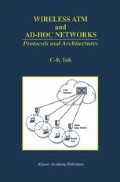Abstract
This chapter is concerned with the protocol aspects for ad-hoc mobile networks. In particular, it reveals what are the problems associated with routing in such networks. Although several routing schemes have been proposed, most of them are modified extensions of existing link-state or distance-vector based routing protocols. However, in an ad-hoc mobile network where mobile hosts are acting as routers and have both power and bandwidth constraints, conventional routing protocols which employ periodic broadcast are unlikely to be suitable. Consequently, there is a need for a simple, bandwidth-efficient and robust routing protocol for ad-hoc mobile networks.
Access this chapter
Tax calculation will be finalised at checkout
Purchases are for personal use only
Preview
Unable to display preview. Download preview PDF.
Notes
Refers to moves causing link changes with the MH’s neighbours.
Forwarding delay refers to all processing, queuing, carrier sensing and transmission delays. Forwarding delay measurements are exponentially smoothed and stored on a per-neighbour MH basis, as in PRNs. The cumulative forwarding delay, therefore, reflects the end-to-end delay of the route concerned.
Route hop count can be deduced from the number of nodes in the route.
RN[1] will be explained in the next section.
LQ[H] will be explained in the next section. Note that ‘H’ refers to ‘LIVE’ of BQ and LQ packets.
Downstream nodes’ movements are not a concern in this case.
Time complexity refers to the number of steps required to perform a protocol operation. Communication complexity refers to the number of messages exchanged in performing a protocol operation.
The common assumption here for complexity comparison which applies to the routing protocols concerned is that the discovery and RRC processes will succeed once initiated and there are no re-attempts.
Both the IEEE 802.11 Committee proposed DF-WMAC (Distributed Foundation-Wireless Media Access Control) and the ETSI HIPERLAN MAC [154] are based on CSMA. CSMA was originally designed for radio networks.
Author information
Authors and Affiliations
Rights and permissions
Copyright information
© 1997 Springer Science+Business Media New York
About this chapter
Cite this chapter
Toh, CK. (1997). The Cambridge Ad-Hoc Mobile Routing Protocol. In: Wireless ATM and Ad-Hoc Networks. Springer, Boston, MA. https://doi.org/10.1007/978-1-4615-6307-5_9
Download citation
DOI: https://doi.org/10.1007/978-1-4615-6307-5_9
Publisher Name: Springer, Boston, MA
Print ISBN: 978-1-4613-7896-9
Online ISBN: 978-1-4615-6307-5
eBook Packages: Springer Book Archive

